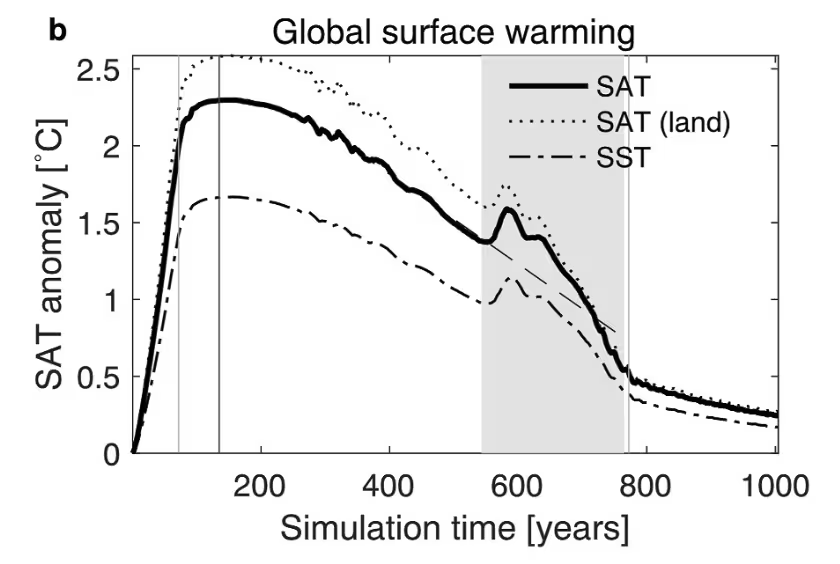5 Minutes
The Southern Ocean has quietly soaked up a century of heat and carbon from human activity. New climate simulations suggest that this reservoir of hidden warmth could be released abruptly centuries from now — producing a global pulse of warming even after we reach net-negative emissions.
How a cold ocean builds a hot problem
Researchers from Germany used an integrated climate framework — combining atmospheric energy and moisture balance, ocean circulation and sea ice physics, land biosphere dynamics and ocean biochemistry — to run an idealized future scenario. In that scenario, greenhouse gas emissions climb for decades and atmospheric CO2 roughly doubles, then are rapidly reduced to become net-negative for several centuries.
Under warming, the ocean acts like a slow piston: surface waters take up excess heat, and some of that warmth is transported downward by changes in circulation. At the same time, loss of reflective sea ice increases absorption of shortwave solar radiation at high latitudes, especially around Antarctica. Those processes let the Southern Ocean stockpile more heat than it releases.
In the model, even after atmospheric CO2 falls and the planet begins long-term cooling, the Southern Ocean continues to release stored heat. That release is abrupt and pronounced — the team calls it a 'burp' — producing global atmospheric warming with a rate similar to historical human-driven warming and persisting for more than a century.

Global surface air temperature (solid line), land surface air temperature (dotted line), and sea surface temperature warming (dashed line). Values are shown as anomalies compared to preindustrial conditions. The 'burp' is indicated with gray shading. (Frenger et al., AGU Advances, 2025)
Why the timing and geography matter
Two features make this mechanism especially important for climate policy. First, the delayed warming is not tightly coupled to contemporary CO2 emissions: warming can continue — or re-emerge — long after emissions drop. That challenges the simple expectation that reaching net-zero or net-negative emissions will quickly halt further temperature rise.
Second, the modeled warming is uneven. The Southern Hemisphere experiences the largest and longest-lasting temperature increases, in part because the Southern Ocean is the main source of the released heat. This asymmetry implies disproportionate impacts on nations in the global south, many of which are already more vulnerable to climate extremes, sea level rise, and ecosystem stress.
- Ocean heat uptake: Deep and intermediate waters store heat transported from the surface.
- Sea ice loss: Reduced albedo increases solar absorption at high latitudes.
- Circulation slowdown: Changes in upwelling and ventilation delay heat escape.
How robust are the results?
The authors tested the scenario across different model setups and found consistent qualitative behavior: the Southern Ocean’s stored heat can be emitted later, producing a century-scale warming pulse. That said, these are idealized simulations. Real-world uncertainties remain in ocean mixing rates, Antarctic ice dynamics, and future emission pathways.
Still, the finding has practical implications. If a delayed ocean-driven warming pulse is possible, then the timeframe for climate benefits from aggressive mitigation lengthens — perhaps by centuries. Policymakers and planners may need to account for long-term ocean memory, not just atmospheric CO2 budgets, when estimating climate risks and adaptation needs.
What this means for climate action and adaptation
Mitigation remains essential: the larger and longer we delay emissions reductions, the bigger the ocean’s stored energy and the larger any future release could be. But this research also highlights the urgency of bolstering long-term adaptation, especially in southern mid- and high-latitude regions and vulnerable southern-hemisphere nations that may face disproportionate warming.
Observational programs, enhanced ocean monitoring, and improved models of Southern Ocean circulation and sea ice are critical to narrow uncertainties. Investments in resilient infrastructure, coastal protection, and climate finance for vulnerable countries will help manage the risks if such a 'burp' occurs.
Expert Insight
Dr. Maya R. Solberg, an ocean-climate scientist not involved with the study, says: 'This work reminds us that the ocean has a long memory. Even if we drive emissions down quickly, past warming is not instantly erased. The Southern Ocean’s role as a heat bank means long-term planning is non-negotiable — both for mitigation and for adaptation in particularly exposed regions.'
In short: the Southern Ocean’s hidden heat is not just an academic curiosity. It is a potential amplifier of future warming that could reshape expectations about how fast and where the climate will respond to human action.
Source: sciencealert
Comments
atomwave
Wait is this model realistic? so many unknowns in Antarctic ice and mixing. Sounds plausible but maybe over sensitive, curious to see obs data
bioNix
Wow didnt expect the ocean to hoard heat like that. If that 'burp' shows up centuries later, we're still paying for today's choices. ugh


Leave a Comment